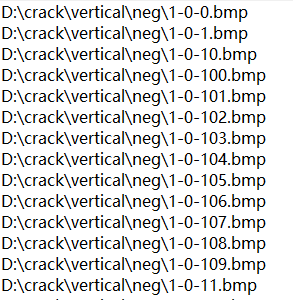opencv分类器训练中,出错一般都是路径出错,例如,
1.opencv_traincascade.exe路径

2.负样本路径文件,neg.dat中的样本前路径是否正确

3.移植到别的电脑并修改完路径后,最好重新生成正样本描述文件,pos.vec
4.同时修改cmd命令中的相关路径

5.我总感觉cmd命令或者opencv训练程序有记忆功能,修改了参数还是训练报错,我一般会重启电脑,或者将cmd命令薄.bat文件修改个名字
6.附录训练时的各种参数
Command line arguments of opencv_traincascade application grouped by purposes:
- Common arguments:
-data <cascade_dir_name>: Where the trained classifier should be stored. This folder should be created manually beforehand.-vec <vec_file_name>: vec-file with positive samples (created by opencv_createsamples utility).-bg <background_file_name>: Background description file. This is the file containing the negative sample images.-numPos <number_of_positive_samples>: Number of positive samples used in training for every classifier stage.-numNeg <number_of_negative_samples>: Number of negative samples used in training for every classifier stage.-numStages <number_of_stages>: Number of cascade stages to be trained.-precalcValBufSize <precalculated_vals_buffer_size_in_Mb>: Size of buffer for precalculated feature values (in Mb). The more memory you assign the faster the training process, however keep in mind that-precalcValBufSizeand-precalcIdxBufSizecombined should not exceed you available system memory.-precalcIdxBufSize <precalculated_idxs_buffer_size_in_Mb>: Size of buffer for precalculated feature indices (in Mb). The more memory you assign the faster the training process, however keep in mind that-precalcValBufSizeand-precalcIdxBufSizecombined should not exceed you available system memory.-baseFormatSave: This argument is actual in case of Haar-like features. If it is specified, the cascade will be saved in the old format. This is only available for backwards compatibility reasons and to allow users stuck to the old deprecated interface, to at least train models using the newer interface.-numThreads <max_number_of_threads>: Maximum number of threads to use during training. Notice that the actual number of used threads may be lower, depending on your machine and compilation options. By default, the maximum available threads are selected if you built OpenCV with TBB support, which is needed for this optimization.-acceptanceRatioBreakValue <break_value>: This argument is used to determine how precise your model should keep learning and when to stop. A good guideline is to train not further than 10e-5, to ensure the model does not overtrain on your training data. By default this value is set to -1 to disable this feature.
- Cascade parameters:
-stageType <BOOST(default)>: Type of stages. Only boosted classifiers are supported as a stage type at the moment.-featureType<{HAAR(default), LBP}>: Type of features: HAAR - Haar-like features, LBP - local binary patterns.-w <sampleWidth>: Width of training samples (in pixels). Must have exactly the same value as used during training samples creation (opencv_createsamples utility).-h <sampleHeight>: Height of training samples (in pixels). Must have exactly the same value as used during training samples creation (opencv_createsamples utility).
- Boosted classifer parameters:
-bt <{DAB, RAB, LB, GAB(default)}>: Type of boosted classifiers: DAB - Discrete AdaBoost, RAB - Real AdaBoost, LB - LogitBoost, GAB - Gentle AdaBoost.-minHitRate <min_hit_rate>: Minimal desired hit rate for each stage of the classifier. Overall hit rate may be estimated as (min_hit_rate ^ number_of_stages), [180] §4.1.-maxFalseAlarmRate <max_false_alarm_rate>: Maximal desired false alarm rate for each stage of the classifier. Overall false alarm rate may be estimated as (max_false_alarm_rate ^ number_of_stages), [180] §4.1.-weightTrimRate <weight_trim_rate>: Specifies whether trimming should be used and its weight. A decent choice is 0.95.-maxDepth <max_depth_of_weak_tree>: Maximal depth of a weak tree. A decent choice is 1, that is case of stumps.-maxWeakCount <max_weak_tree_count>: Maximal count of weak trees for every cascade stage. The boosted classifier (stage) will have so many weak trees (<=maxWeakCount), as needed to achieve the given-maxFalseAlarmRate.
- Haar-like feature parameters:
-mode <BASIC (default) | CORE | ALL>: Selects the type of Haar features set used in training. BASIC use only upright features, while ALL uses the full set of upright and 45 degree rotated feature set. See [103] for more details.
- Local Binary Patterns parameters: Local Binary Patterns don't have parameters.
After the opencv_traincascade application has finished its work, the trained cascade will be saved in cascade.xml file in the -data folder. Other files in this folder are created for the case of interrupted training, so you may delete them after completion of training.
Training is finished and you can test your cascade classifier!
Visualising Cascade Classifiers
From time to time it can be usefull to visualise the trained cascade, to see which features it selected and how complex its stages are. For this OpenCV supplies a opencv_visualisation application. This application has the following commands:
--image(required) : path to a reference image for your object model. This should be an annotation with dimensions [-w,-h] as passed to both opencv_createsamples and opencv_traincascade application.--model(required) : path to the trained model, which should be in the folder supplied to the-dataparameter of the opencv_traincascade application.--data(optional) : if a data folder is supplied, which has to be manually created beforehand, stage output and a video of the features will be stored.
知识付费时代,觉得对您有帮助的,别忘了打赏,附微信收款码
